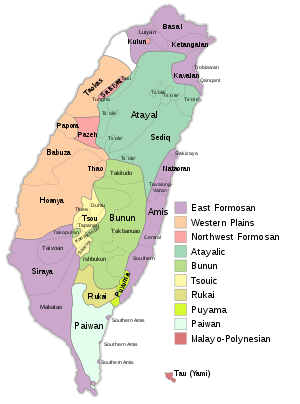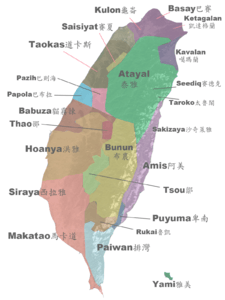Kanakanabu language
| Kanakanavu | |
|---|---|
| Native to | Taiwan |
| Region | Kaohsiung County Sanmin Township Minchuan Village Area |
| Ethnicity | 250 (no date)[1] |
Native speakers | 4 (2012)[2] |
|
Austronesian
| |
| Language codes | |
| ISO 639-3 |
xnb |
| Glottolog |
kana1286[3] |
Kanakanavu (also spelled Kanakanabu) is a Southern Tsouic language is spoken by the Kanakanavu people, an indigenous people of Taiwan (see Taiwanese aborigines). It is a Formosan language of the Austronesian family.
The Kanakanavu live in the two villages of Manga and Takanua in Namasia District (formerly Sanmin Township), Kaohsiung.[4]
The language is considered to be moribund.[5]
History
The native Kanakanavu speakers were Taiwanese aboriginals living on the islands. Following the Dutch Colonial Period in the 17th century, Han-Chinese immigration began to dominate the islands population. The village of Takanua is a village assembled by Japanese rulers to relocate various aboriginal groups in order to establish easier dominion over these groups.[6]
Language Description
There are 14 different consonant phonemes, containing only voiceless plosives within Kanakanavu. Adequate descriptions of liquid consonants become a challenge within Kanakanavu. It also contains 6 vowels plus diphthongs and triphthongs. Vowel length is often not clear if distinctive or not, as well as speakers pronouncing vowel phonemes with variance. As most Austronesian and Formosan languages, Kanakanavu has the syllable structure C V. Very few, even simple words, contain less than three to four syllables.[7]
Alphabet
A, C, E, I, K, L, M, N, Ng, O, P, R, S, T, U, Ʉ, V, ' /ʔ.
C represents the phoneme /c/.
L represents the phonemes /ɗ/ and /ɽ/.
P represents both /ɓ/ and /p/.
/ɫ/ is spelled as hl.
Phonology
Consonants
| Labial | Dental | Alveolar | Retroflex | Palatal | Velar | Glottal | |
|---|---|---|---|---|---|---|---|
| Nasal | m | n | ŋ ⟨ng⟩ | ||||
| Stop | p ɓ ⟨p⟩ | t | ɖ ⟨l⟩ | c | k | ʔ ⟨'⟩ | |
| Affricate | |||||||
| Fricative | f v | s z | h | ||||
| Rhotic | ɽ | ||||||
| Approximant | w | ɫ ⟨hl⟩ | ɭ | j ⟨y⟩ |
Vowels
Front: i, e, a
Central: ʉ, e/ə
Back: u, o
References
- ↑ Kanakanabu language at Ethnologue (15th ed., 2005)
- ↑ Kanakanavu at Ethnologue (18th ed., 2015)
- ↑ Hammarström, Harald; Forkel, Robert; Haspelmath, Martin, eds. (2017). "Kanakanavu". Glottolog 3.0. Jena, Germany: Max Planck Institute for the Science of Human History.
- ↑ Zeitoun & Teng (2014), abstract.
- ↑ Did you know Kanakanabu is critically endangered? (n.d.). Retrieved April 15, 2016, from http://www.endangeredlanguages.com/lang/3236
- ↑ https://www2.uni-erfurt.de/sprachwissenschaft/Vgl_SW/kanakanavu/language-description/setting-of-language/ethnographic-situation.html https://www2.uni-erfurt.de/sprachwissenschaft/Vgl_SW/kanakanavu/language-description/setting-of-language/ethnographic-situation.html
- ↑ https://www2.uni-erfurt.de/sprachwissenschaft/Vgl_SW/kanakanavu/language-description/system-of-language/distinctive-system-2/phonology.html https://www2.uni-erfurt.de/sprachwissenschaft/Vgl_SW/kanakanavu/language-description/system-of-language/distinctive-system-2/phonology.html
Further reading
- Pejros, I. (1994). Some Problems of Austronesian Accent and *T ~ *C (Notes of an Outsider). Oceanic Linguistics, 33(1), 105–127.JSTOR 3623002
- Adelaar, K. A., Pawley, A., & Blust, R. A. (2009). Austronesian historical linguistics and culture history: A festschrift for Robert Blust (Vol. 601). Canberra: Pacific Linguistics, Research School of Pacific and Asian Studies, Australian National University.
- Dyen, I. (2005). Some Notes on the Proto-Austronesian Words for 'Water'. Oceanic Linguistics, 44(1), 1–11. JSTOR 3623228
- Kanakanabu. (n.d.). Retrieved 8 February 2016, from https://www.ethnologue.com/language/xnb
- Lehmann, C. (n.d.). Kanakanavu. Retrieved 8 February 2016, from https://www2.uni-erfurt.de/sprachwissenschaft/Vgl_SW/kanakanavu/language-description/setting-of-language/ethnographic-situation.html
- Li, Paul Jen-Kuei (2004). "Basic Vocabulary for Formosan Languages and Dialects". Selected papers on Formosan languages (in English and Chinese). Taipei: Institute of Linguistics, Academia Sinica. ISBN 9789570184136.
- Pejros, I. (1994). Some Problems of Austronesian Accent and *T ~ *C (Notes of an Outsider). Oceanic Linguistics, 33(1), 105–127. JSTOR 3623002
- Ross, M. (2012). N Defense of Nuclear Austronesian. Language and Linguistics, 13, 1253–1330. Retrieved 8 February 2016.
- Tsuchida, Shigeru. (1975). Reconstruction of Proto-Tsouic Phonology. Yale University. 361pp. (Doctoral dissertation).
- Tsuchida, Shigeru. (1976). Reconstruction of Proto-Tsouic phonology. (Study of languages and cultures of Asia and Africa : monograph series, 5.) Tokyo: Institute for the Study of Languages and Cultures of Asia and Africa, Tokyo Univ. of Foreign Studies. 329pp. (Corrigenda and addenda slip inserted Includes index Bibliography: S. xi-xxiv).
- Tsuchida, Shigeru. (2003). Kanakanavu texts (Austronesian Formosan). (Endangered Languages of the Pacific Rim Publications Series, A3-014.) Osaka: ELPR. 133pp.

